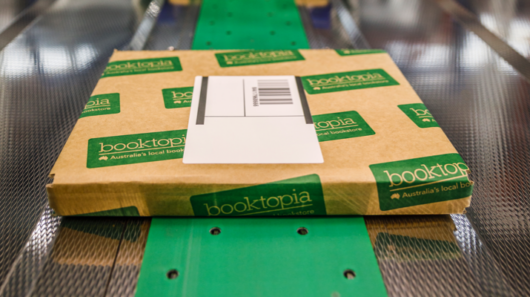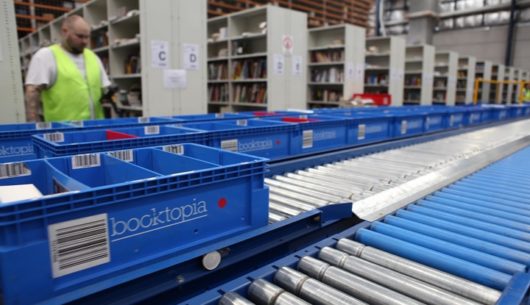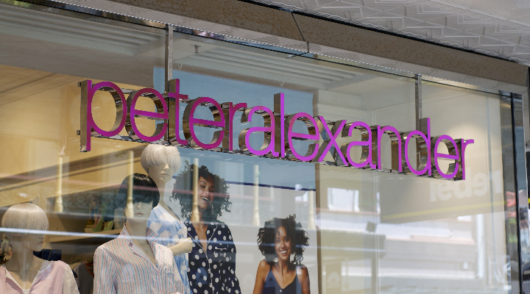 Over the past 14 years, Booktopia has grown from a company with a budget of $10 a day to an e-commerce juggernaut on track to reach $120 million for the year.
Over the past 14 years, Booktopia has grown from a company with a budget of $10 a day to an e-commerce juggernaut on track to reach $120 million for the year.
Founded on the February 4, 2004 by Tony and Simon Nash, and Steve Traurig, the company sold its first book within three days of opening.
Now, it pushes 20,000 orders through its distribution centre a day, reaching a volume high of approximately 35,000 during seasonal periods.
“How did we do that? We focused on our customers,” CEO and founder Tony Nash explains to IRW.
“That was always the bottom line question we asked, ‘is this good for our customers?’”
The growth of the company was recently acknowledged at the Online Retailer Expo Awards, with Booktopia winning the Best Pureplay Online Retailer Award, though Nash hasn’t let the excitement get to him.
“What I notice about other entrepreneurs is that when things go bad, they ride the roller coaster of emotion down to the very bottom and it’s like the worst thing that ever happened to them,” says Nash.
“They’re furious, they’re angry, and then when things go great, they party.
“I don’t go down there, but at the same time, I also don’t over-celebrate the highs. It’s great that we won that, but what does that mean? To win, to be recognised, is not the destination.
“It’s just a signpost to say you’re on track.”
Despite the success of the business, there is an Amazon-shaped shadow on the horizon that has led the management team to rethink and refocus the core of the business in order to remain relevant.
“Our competitive advantage over Amazon is our niche,” says CTO Wayne Baskin during a hosted tour of the company’s distribution centre.
“We look at other markets, like Canada, where companies that have stuck to their range and haven’t tried to be everything to everyone. You’re not going to beat Amazon at being everything to everyone.”
The plan, then, is to refocus on the company’s origins to become even more integrated within the Australian book industry.
“As Amazon was announcing that they would be arriving [in Australia], we did some deep thinking about how we’re going to be successful, [and] we realised that we actually have to focus on books,” says Nash.
“The more we focus on books, and be that one vertical to one group of customers, rather than Amazon who is everything to everyone, [that] was the way for us to move forward.”
Nash notes that if a company focuses on one thing, and does it well, they can flourish despite the US e-commerce giant’s ominous presence.
IBISWorld Senior Industry Analyst Kim Do agrees, pointing out that by focusing on one product, rather than adding other verticals to the business model, the company can increase operating efficiencies and cement itself as Australia’s leading book retailer.
“At the moment online book sales only account for about 27 per cent of total book sales,” says Do.
“This figure is expected to increase to over 50 per cent in the next five years, similar to current levels in the US and Europe, indicating there is still room for Booktopia to grow.”
Do continues, noting that by offering one core product the company will be able to focus on providing superior customer service to attain, and retain, customers.
“The good thing about books is that it is a very complex range of titles across 27 million active SKUs,” says Nash.
“Thing’s go out of print, get superseded with a new edition, you can get cheaper ones from overseas. It’s very personal [reason] why one is better than another, [then] there’s these unexpected fads like adult colouring books, or a particular author, Dan Brown’s Da Vinci Code [for example], all of a sudden things just happen.
“For those that want to plan, or those that want to believe there is an area of predictability, there’s a…lack of predictability in our industry.”
Nash points out that while books were once a large portion of Amazon’s model, the industry now makes up US$6 billion of the company’s total US$170 billion revenue.
“It used to be all of their revenue, [then it was] half of their revenue, 10 per cent, it’s not even 4 per cent any more, it’s 3 percent,” Nash points out, “books [are] not important to them anymore. It used to be, but they’ve moved on.”
Powering the marketplace of books
Key to Booktopia’s renewed focus on it’s roots is it’s Sydney distribution centre, which allows the company to push out mammoth volume of orders per day, though not all of these orders are directly from Booktopia’s online storefront.
“We decided to set-up a business within our business, which is wholesale distribution,” explains Nash.
“So, now other than being a retailer who is buying books from publishers, we’re now also saying to publishers internationally, ‘we can be your distributor in Australia’.
“We’ve got all the investment already, so now bookshops are buying from us, we’re buying from ourselves so…in terms of our future, we’re doing more and more of that.”
The company serves as an online distributor for marketplaces such as Myer, Catch, Ebay and Trade Me, while also powering Kogan books, with orders processed and shipped from the single distribution centre, though items are labelled depending on where the customer has purchased from.
“They get Kogan labels put on the parcels [and] it’s got Kogan as the shipper, and that’s what works for that relationship,” says Nash.
“Whereas with Catch, because it’s a marketplace, people know they’re buying on the Catch website from Booktopia. We can do both.”
Baskin notes that, because of this, the distribution centre needs to be generic, as it needs to fulfill the needs of several businesses at once, while also being purpose built to be as efficient as possible.
“Our theory is we want to sell books wherever the book buyer is. Why chase the book buyer? Let’s go where the book buyer wants to buy their books,” says Baskin.
Being involved in so many marketplaces leads to heightened control of prices, despite competitors actively undercutting.
“We currently don’t price scrape at all. The Book Depository is our biggest competitor in Australia, and we know that they scrape us,” notes Baskin.
“We often see that their products are 50c cheaper, a dollar cheaper than ours, which we let happen It’s a race to the bottom.”
Despite the lower prices, The Book Depository offers shipping in 14 days while Booktopia offers delivery next day, Baskin noting that the extra 50c is generally worth getting a product 10 to 12 days earlier.
Do notes that the reason for this shipping discrepancy is that Amazon-owned Book Depository is based in the UK.
“Although Amazon will definitely expand its range of books on their local website in the long run, it is unlikely to be as extensive as The Book Depository,” says Do.
“The main problem here is that Amazon does not want to cannibalise its own sales and hence must find a model that will benefit both.”
Distributing nexus
Despite fulfilling orders for several online storefronts, Booktopia works out of a single distribution centre, totalling 13,000 square metres, and employing 190 full-time equivalent employees.
While the website boasts 27 million SKUs, with 6 million generally available at a time, the distribution centre only holds around 150,000 titles which make up 85 per cent of total units sold.
“It’s the chicken or the egg,” explains Baskin, “do we sell 85 per cent because we have it in stock, because on our website it says ‘ships today’, or do we sell it because our buyers are really good at knowing what’s [popular]? That’s always a great argument we have in the business.”
The remaining 4.863 million is shipped from a supplier to the distribution centre, where it is checked and shipped to the customer.
While Booktopia only has a single distribution centre, the company has no plans to expand and add alternate centres through the country, according to Nash.
“At the moment we’re more interested in getting very fast delivery lanes,” Nash explains, “[it’s] probably a better financial solution and a better customer solution than trying to build another centre… and have another team.”
Over the period that Booktopia has been in business the book industry has feared the death of physical books, the end of book shops, and the coming of e-readers such as the Amazon Kindle.
These things have not come to pass, with the industry now seeing a revived interest in physical books over ebooks.
“Book sales are not declining, retail sales are not declining, there’s just a changing of the guard,” says Nash.
“The Gerry Harveys and the Solomon Lews of the world…have not needed to be as adaptive.
“In Australia, we’ve been fortunate to be so far away from everyone else that the old retailers were able to get away with it for so long, but the truth is that online retail will be 15 to 20 per cent [of total retail sales], so who’s going to have that business?”
“You can either focus on the negative, and all the reasons why things aren’t happening, or you can put that aside and [ask], ‘where are the opportunities? What can we take advantage of?’”
This story initially appeared in Inside Retail Weekly 2200. Subscribe today and get our premium print publication delivered to your door every week.





